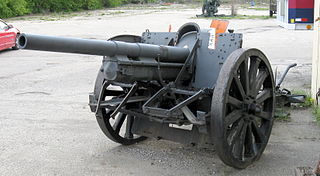
An explosive is a reactive substance that contains a great amount of potential energy that can produce an explosion if released suddenly, usually accompanied by the production of light, heat, sound, and pressure. An explosive charge is a measured quantity of explosive material, which may either be composed solely of one ingredient or be a mixture containing at least two substances.

2,4,6-Trinitrophenylmethylnitramine commonly referred to as tetryl (C7H5N5O8) is an explosive compound used to make detonators and explosive booster charges.

Sodium hydroxide, also known as lye and caustic soda, is an inorganic compound with the formula NaOH. It is a white solid ionic compound consisting of sodium cations Na+ and hydroxide anions OH−.

Picric acid is an organic compound with the formula (O2N)3C6H2OH. Its IUPAC name is 2,4,6-trinitrophenol (TNP). The name "picric" comes from Greek: πικρός (pikros), meaning "bitter", due to its bitter taste. It is one of the most acidic phenols. Like other strongly nitrated organic compounds, picric acid is an explosive, which is its primary use. It has also been used as medicine (antiseptic, burn treatments) and as a dye.

Ammonium nitrate is a chemical compound with the chemical formula NH4NO3. It is a white crystalline salt consisting of ions of ammonium and nitrate. It is highly soluble in water and hygroscopic as a solid, although it does not form hydrates. It is predominantly used in agriculture as a high-nitrogen fertilizer. Global production was estimated at 21.6 million tonnes in 2017.

Oleum, or fuming sulfuric acid, is a term referring to solutions of various compositions of sulfur trioxide in sulfuric acid, or sometimes more specifically to disulfuric acid. Oleum is identified by the CAS number 8014-95-7.

A corrosive substance is one that will damage or destroy other substances with which it comes into contact by means of a chemical reaction.

Potassium chlorate is a compound containing potassium, chlorine and oxygen, with the molecular formula KClO3. In its pure form, it is a white crystalline substance. After sodium chlorate, it is the second most common chlorate in industrial use. It is a strong oxidizing agent and its most important application is in safety matches. In other applications it is mostly obsolete and has been replaced by safer alternatives in recent decades. It has been used
An explosive booster is a sensitive explosive charge that acts as a bridge between a conventional detonator and a low-sensitivity explosive such as TNT. By itself, the initiating detonator would not deliver sufficient energy to set off the low-sensitivity charge. However, it detonates the primary charge, which then delivers an explosive shockwave that is sufficient to detonate the secondary, main, high-energy charge.

Silver fulminate (AgCNO) is the highly explosive silver salt of fulminic acid.
Armstrong's mixture is a highly sensitive primary explosive. It is very friction-sensitive. Formulations vary, but one consists of 67% potassium chlorate, 27% red phosphorus, 3% sulfur, and 3% calcium carbonate. It is named for Sir William Armstrong, who invented it sometime prior to 1872 for use in explosive shells.

Ammonium chlorate is an inorganic compound with the formula NH4ClO3.
Kinetite was an explosive material patented in 1884 by T. Petry and O. Fallenstein, It consisted of nitro-benzol thickened or gelatinised by the addition of some collodion-cotton incorporated with finely ground potassium chlorate and precipitated antimony sulphide. It is an orange coloured, plastic mass, with the characteristic strong smell of nitro-benzol. It was manufactured by dissolving gun cotton in nitrobenzene.
A pyrotechnic composition is a substance or mixture of substances designed to produce an effect by heat, light, sound, gas/smoke or a combination of these, as a result of non-detonative self-sustaining exothermic chemical reactions. Pyrotechnic substances do not rely on oxygen from external sources to sustain the reaction.

A picrate is a salt containing the anion (O2N)3C6H2O− or an ester derivative of the picrate anion. These salts are often produced by reactions of picric acid (2,4,6-trinitrophenol). The picrate ion is intensely yellow, although many of its salts are brown or orange-red.

The 7.7 cm Feldkanone 16 was a field gun used by Germany in World War I. Most surviving examples in German service were rebarreled after the war as the 7.5 cm FK 16 nA. A total of 298 guns of the old type were still in German army service in 1939, making it the oldest field artillery piece in German inventory at the beginning of the Second World War.

Lead picrate is an organic picrate salt. It is a sensitive and highly explosive compound that is typically found as a hydrate. Dry lead picrate is incredibly dangerous and cannot be handled without explosive decomposition occurring.
Barium perchlorate is a powerful oxidizing agent, with the formula Ba(ClO4)2. It is used in the pyrotechnic industry.

Shellite is an explosive mixture of picric acid and dinitrophenol or picric acid and hexanitrodiphenylamine in a ratio of 70/30. It was typically used as a filling in Royal Navy armour-piercing shells during the early part of the 20th century.
















